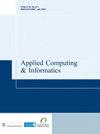使用机器学习技术的电子邮件分类分析
IF 4.9
Q1 COMPUTER SCIENCE, INFORMATION SYSTEMS
引用次数: 5
摘要
目的在这个数字时代,电子邮件是人与人之间最普遍的交流方式。许多用户成为垃圾邮件的受害者,他们的数据被曝光。设计/方法论/方法研究人员通过关注先进的机器学习算法和改进的垃圾邮件检测模型来解决这个问题,但在功能上仍然存在差距。要想取得好的效果,特色也发挥着重要作用。为了评估应用分类器的性能,使用了10倍交叉验证。结果表明,与其他应用的机器学习分类器相比,支持向量机和人工神经网络对垃圾邮件的分类准确率分别为98.00%和98.06%。原创性/价值在本文中,将点双序列相关性应用于加州大学欧文分校(UCI)垃圾邮件库电子邮件数据集的类标签的每个特征,以选择最佳特征。通过训练不同的分类器,对所选择的特征进行了广泛的实验。本文章由计算机程序翻译,如有差异,请以英文原文为准。
Email classification analysis using machine learning techniques
PurposeIn this digital era, email is the most pervasive form of communication between people. Many users become a victim of spam emails and their data have been exposed.Design/methodology/approachResearchers contribute to solving this problem by a focus on advanced machine learning algorithms and improved models for detecting spam emails but there is still a gap in features. To achieve good results, features also play an important role. To evaluate the performance of applied classifiers, 10-fold cross-validation is used.FindingsThe results approve that the spam emails are correctly classified with the accuracy of 98.00% for the Support Vector Machine and 98.06% for the Artificial Neural Network as compared to other applied machine learning classifiers.Originality/valueIn this paper, Point-Biserial correlation is applied to each feature concerning the class label of the University of California Irvine (UCI) spambase email dataset to select the best features. Extensive experiments are conducted on selected features by training the different classifiers.
求助全文
通过发布文献求助,成功后即可免费获取论文全文。
去求助
来源期刊

Applied Computing and Informatics
Computer Science-Information Systems
CiteScore
12.20
自引率
0.00%
发文量
0
审稿时长
39 weeks
期刊介绍:
Applied Computing and Informatics aims to be timely in disseminating leading-edge knowledge to researchers, practitioners and academics whose interest is in the latest developments in applied computing and information systems concepts, strategies, practices, tools and technologies. In particular, the journal encourages research studies that have significant contributions to make to the continuous development and improvement of IT practices in the Kingdom of Saudi Arabia and other countries. By doing so, the journal attempts to bridge the gap between the academic and industrial community, and therefore, welcomes theoretically grounded, methodologically sound research studies that address various IT-related problems and innovations of an applied nature. The journal will serve as a forum for practitioners, researchers, managers and IT policy makers to share their knowledge and experience in the design, development, implementation, management and evaluation of various IT applications. Contributions may deal with, but are not limited to: • Internet and E-Commerce Architecture, Infrastructure, Models, Deployment Strategies and Methodologies. • E-Business and E-Government Adoption. • Mobile Commerce and their Applications. • Applied Telecommunication Networks. • Software Engineering Approaches, Methodologies, Techniques, and Tools. • Applied Data Mining and Warehousing. • Information Strategic Planning and Recourse Management. • Applied Wireless Computing. • Enterprise Resource Planning Systems. • IT Education. • Societal, Cultural, and Ethical Issues of IT. • Policy, Legal and Global Issues of IT. • Enterprise Database Technology.
 求助内容:
求助内容: 应助结果提醒方式:
应助结果提醒方式:


